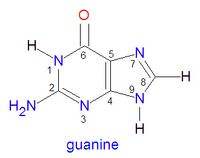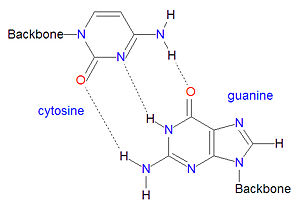Guanine: Difference between revisions
Jump to navigation
Jump to search

imported>David E. Volk m (wikilinks) |
Pat Palmer (talk | contribs) (adding HMDB ref) |
||
| Line 16: | Line 16: | ||
}} | }} | ||
'''Guanine''' is a natural biomolecule used as one of the five bases in [[RNA]] and [[DNA]]. It is incorporated into these [[nucleic acid]]s in the form of [[guanosine]], a chemical compound formed by the combination of guanine and a [[ribose sugar]]. Guanine is also naturally present in phosphorylated forms of [[guanosine]]. | '''Guanine'''<ref name=Guanin>[https://hmdb.ca/metabolites/HMDB0000132 Guanine (HMDB0000132)] in the Human Metabolome Database (HMDB).</ref> is a natural biomolecule used as one of the five bases in [[RNA]] and [[DNA]]. It is incorporated into these [[nucleic acid]]s in the form of [[guanosine]], a chemical compound formed by the combination of guanine and a [[ribose sugar]]. Guanine is also naturally present in phosphorylated forms of [[guanosine]]. | ||
== Basepairs == | == Basepairs == | ||
Revision as of 07:54, 13 July 2024
|
| |||||||
| guanine | |||||||
| |||||||
| Uses: | |||||||
| Properties: | DNA/RNA base | ||||||
| Hazards: | |||||||
| |||||||
Guanine[1] is a natural biomolecule used as one of the five bases in RNA and DNA. It is incorporated into these nucleic acids in the form of guanosine, a chemical compound formed by the combination of guanine and a ribose sugar. Guanine is also naturally present in phosphorylated forms of guanosine.
Basepairs
Guanine and cytosine form a very stable Watson-Crick base pair containing three hydrogen bonds.
- ↑ Guanine (HMDB0000132) in the Human Metabolome Database (HMDB).

